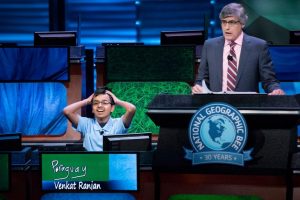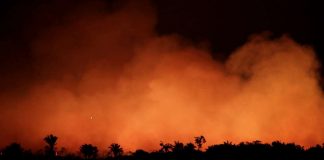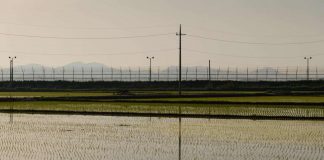MAY 23, 2018
 Venkat Ranjan, 13, is announced as the winner of the National Geographic Bee Wednesday. Mo Rocca hosted the annual geography competition. – Photograph by Mark Thiessen, National Geographic
Venkat Ranjan, 13, is announced as the winner of the National Geographic Bee Wednesday. Mo Rocca hosted the annual geography competition. – Photograph by Mark Thiessen, National Geographic
The 2018 champion was awarded a $50,000 college scholarship, a lifetime membership to the National Geographic Society, including a subscription to National Geographic magazine, and an all-expenses-paid Lindblad expedition to the Galápagos Islands aboard the National Geographic Endeavour ll. Second- and third-place finishers received $25,000 and $10,000 college scholarships, respectively. Vishal Sareddy, 14, of Georgia won third.
“I was always a geography nerd,” Rocca quipped at the start of the final competition. “As a child, one of my favorite days of the year was when the new almanac came out. I paged through, memorizing facts. I almost had a nervous breakdown when the Soviet Union broke up, because there was a cascade of stans. But it’s nothing compared to what these kids know. It’s really inspiring and renews my faith in the future, that there are so many kids that care so much about the world and learning about it.”
During the competition, students had to answer such questions as whether a map of the U.S. shows homelessness or the literacy rate, the range of the black bear or a ponderosa pine, and ferry boardings versus minimum wage. In a test of their analytical and communication skills, contestants were asked to choose one of three rivers as the best choice to focus a plastic cleanup effort, to reduce the amount of waste going into the ocean. All three finalists remaining choose China’s Yangtze River as the best choice, and explained that the area’s high population and plastic consumption, and limited collection and recycling infrastructure, made it the prime target.
Contestants were asked to name the U.S. state capital on the Pearl River, Sweden’s largest island, and the currency of Denmark.
“All of you have demonstrated an impressive commitment to geopgraphy and maps, and today we’re rewarding that commitment,” National Geographic Society chair Jean Case told the audience.
At National Geographic, “we consider ourselves map geeks,” Case added. “But we understand geography is about so much more than just memorizing places on a map.”
Case added that National Geographic co-founder Alexander Graham Bell had definied geography as the world and all that’s in it. And the goal of the Bee is to “educate, inspire, and celebrate you, our young people,” said Case. “Because you are our future leaders.”
Speaking of those future leaders, eight of the students taking part in this year’s National Geographic Bee are repeat state winners.
For the first time, one of the Bee finalists is also a winner of the Scripps National Spelling Bee. Nihar Janga, 13, of Houston, Texas, said he also enjoys football and video games.
Having fun with geography, Rocca asked the finalists to try to stump him. Buddhikot asked Rocca the highest point in New Jersey. “Mount Sopranos?” he quipped. “No, it’s called High Point,” she said.
Other finalists included Gayatri Kaimal of Arizona, 13; Atreya Mallanna of Massachusetts, 11; Sean Cheng of New Hampshire, 14; Jonathan Song of North Carolina, 14; Saket Pochiraju of Ohio, 13; Ashwin Sivakumar of Oregon, 13. (Read about last year’s winners.)
Many more students will compete in future years; Alex Trebek, who hosted the National Geographic Bee for 25 years, recently endowed the program to keep it going in perpetuity.
“The bee goes right to the heart of what we are all about here at National Geographic,” said Case. “We are about furthering understanding of the world and the people in it. We live in an ever connected world.”











































































































